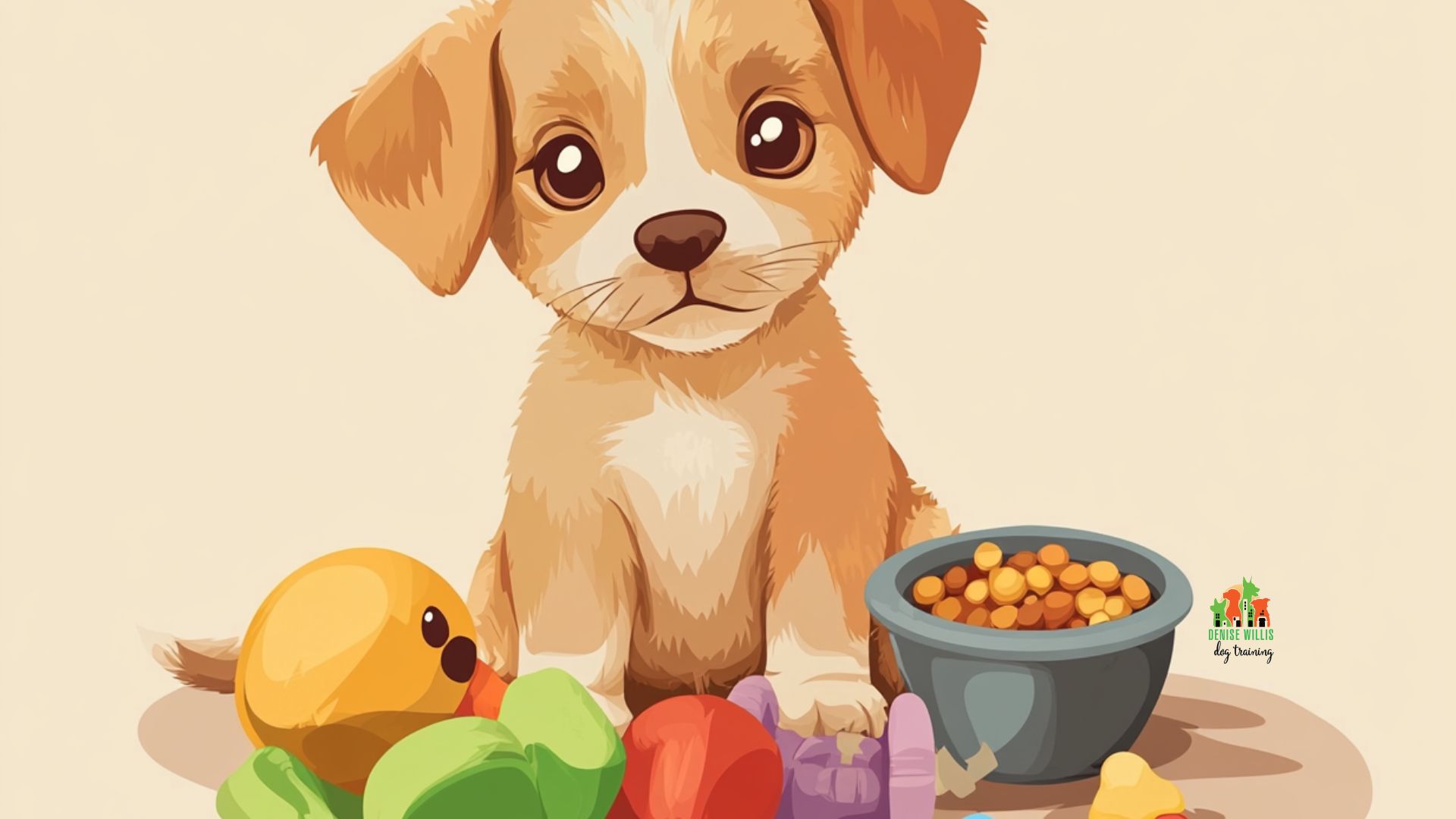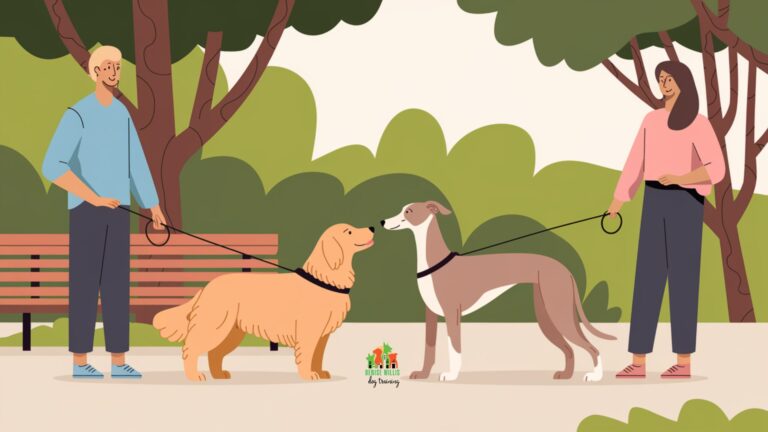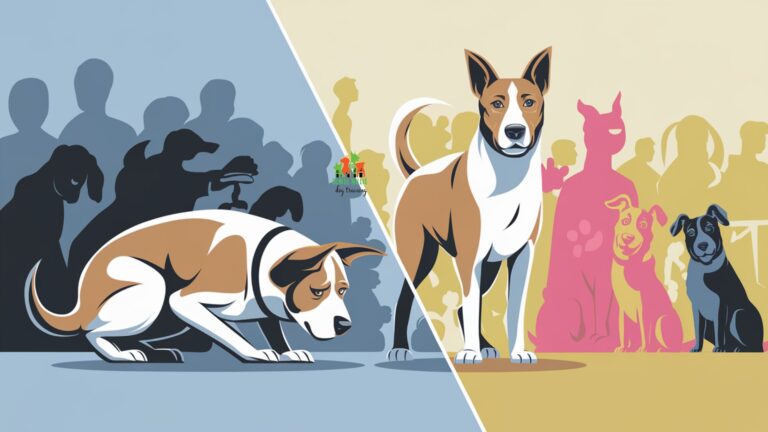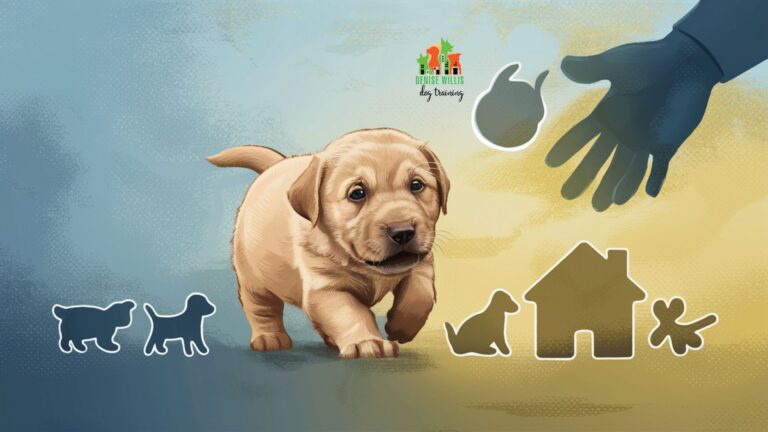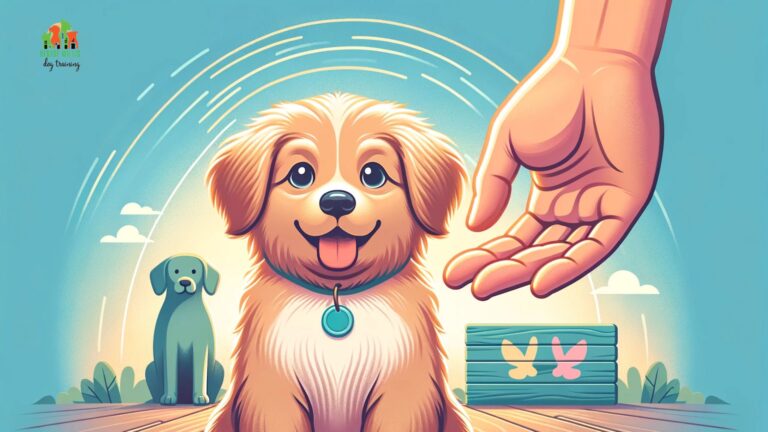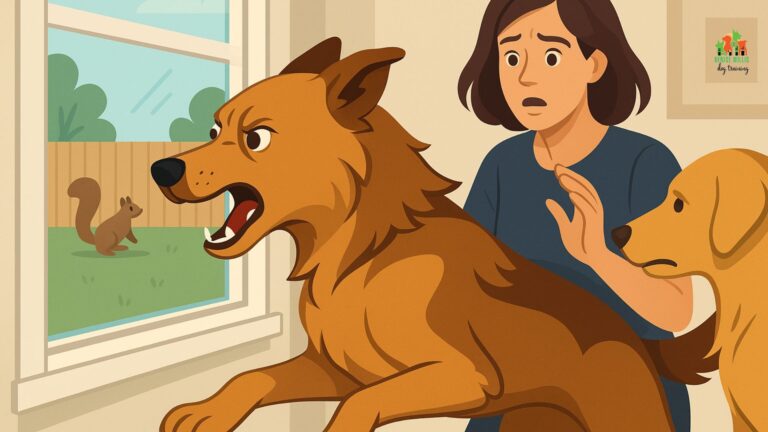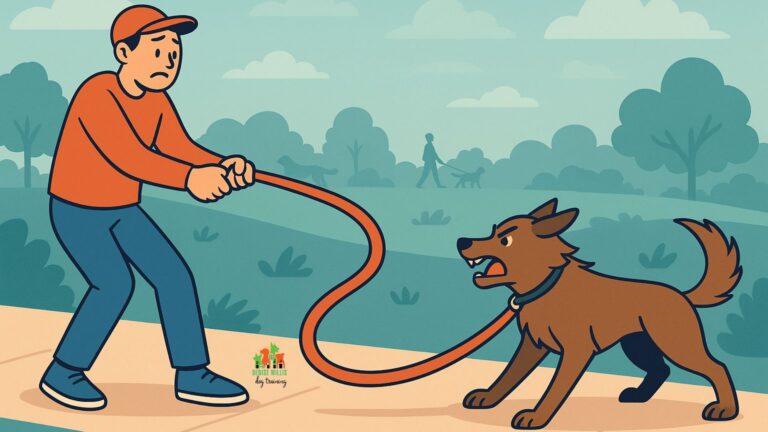10 Simple Steps to Prevent Resource Guarding in Puppies
📍 Service Area Notice: DW Dog Training provides in-person training services exclusively in the Greater Baltimore area. While our blog content is designed to help dog owners internationally, our hands-on training services are locally focused. For readers outside our service area, we hope you find value in our articles and welcome you to reach out with questions!
Is resource guarding in puppies driving you crazy? You’re not alone. As a professional dog trainer in Baltimore, I’ve seen countless frustrated owners dealing with puppies who growl, snap, or worse over their food, toys, or favorite spots.
It’s a natural behavior, but left unchecked, it can lead to serious problems.
The good news? With the right approach, you can nip this issue in the bud. I’ve helped hundreds of dog owners overcome resource guarding, and I’m here to share my tried-and-true methods.
Stick around, and I’ll show you how to turn your little guard dog into a sharing, well-adjusted pup.
Key Takeaways
- Resource guarding is a natural behavior in puppies that can be prevented and managed with proper training.
- Early intervention is crucial in addressing resource guarding behaviors.
- Consistent positive reinforcement and building trust are key to preventing resource guarding.
- Never punish a puppy for resource guarding, as it can worsen the behavior.
- Professional help may be necessary for severe cases of resource guarding.
Understanding Resource Guarding in Puppies
Resource guarding in puppies is a behavior where they become protective over items they consider valuable. This can include food, toys, sleeping areas, or even people. While it’s a natural instinct rooted in survival, excessive guarding can lead to aggression and other behavioral issues if not addressed early.
From an evolutionary perspective, resource guarding made sense for our dogs’ ancestors. In the wild, protecting food and other valuable resources could mean the difference between survival and starvation. However, in our homes, where resources are plentiful, this behavior becomes unnecessary and problematic.
It’s important to understand that resource guarding isn’t about dominance or your puppy trying to be the “alpha.” It’s typically rooted in insecurity or anxiety about losing access to something valuable. By addressing these underlying emotions, we can help our puppies feel more secure and less likely to guard their resources.
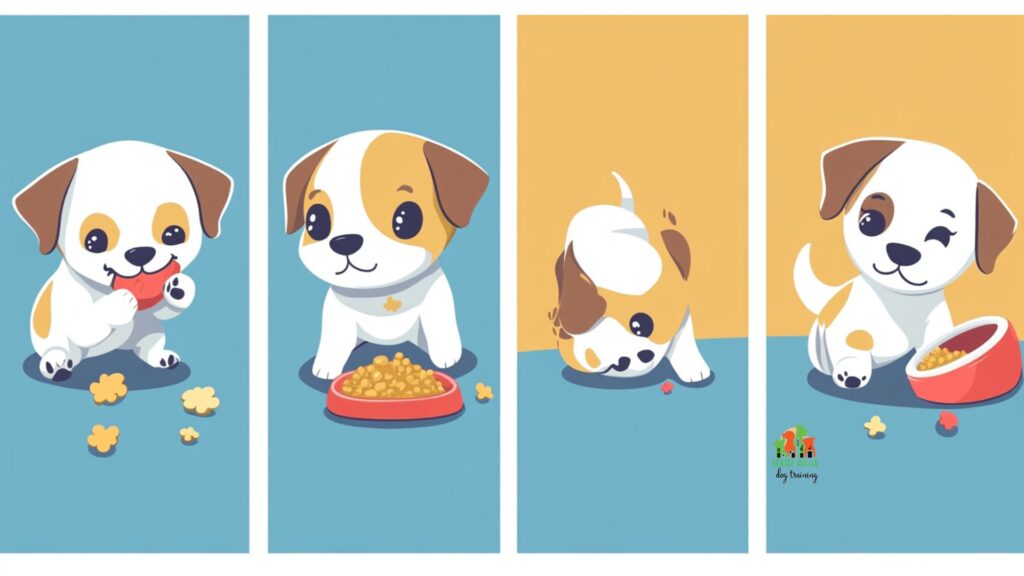
Signs of Resource Guarding
Recognizing the early signs of resource guarding is crucial for effective intervention. Watch out for these behaviors:
- Stiffening or freezing when approached while possessing a resource
- Growling or snarling when someone comes near their valuables
- Snapping or biting when an attempt is made to take the item
- Quickly eating or moving away with the resource when approached
- Showing the whites of their eyes (whale eye) when guarding an item
- Hovering over the item, often with a lowered head posture
- Placing a paw on the item when someone approaches
- Suddenly becoming still and vigilant when in possession of a resource
Remember, these signs can be subtle, especially in the early stages. It’s essential to pay close attention to your puppy’s body language and reactions in various situations.
Resource Guarding in Puppies: 4 Key Points
Early Signs
Stiffening, growling, or snapping when approached while possessing a valued item.
Prevention
Start early with positive reinforcement and trade-up games to build trust.
Training Techniques
Use desensitization and counterconditioning to change your puppy’s emotional response.
Professional Help
Seek expert guidance for severe cases or if you’re unsure how to proceed.
10 Simple Steps to Prevent Resource Guarding
- Start Early: Begin prevention techniques as soon as you bring your puppy home. The earlier you start, the easier it is to shape positive behaviors. Puppies are like sponges, soaking up experiences and learning constantly. By introducing positive associations with sharing and giving up items from day one, you’re setting a strong foundation for the future.
- Provide Plenty of Resources: Ensure your puppy has access to multiple toys, chews, and feeding stations. This reduces competition and the need to guard. In multi-dog households, have separate feeding areas and multiple water bowls. Remember, abundance creates a sense of security.
- Practice the “Trade-Up” Game: Regularly offer your puppy a high-value treat in exchange for a toy or object they have. This teaches them that giving up items leads to good things. Start with low-value items and gradually work up to things your puppy values more highly. The goal is for your puppy to willingly give up items, anticipating something even better in return.
- Hand-Feed Regularly: Spend time hand-feeding your puppy. This builds trust and teaches them that human hands near their food is a positive experience. Start by offering a few pieces of kibble from your hand, then gradually progress to feeding entire meals. This practice not only prevents food guarding but also strengthens your bond with your puppy.
- Teach “Drop It” and “Leave It”: These commands are invaluable for managing potential guarding situations. Use positive reinforcement to make these cues fun and rewarding. “Drop it” should mean “let go of what you have and you’ll get something better.” “Leave it” teaches impulse control and can prevent your puppy from picking up items they shouldn’t have in the first place.
- Never Punish Guarding Behavior: Punishment can increase anxiety and worsen guarding. Instead, focus on positive reinforcement for desired behaviors. If your puppy growls when you approach their food bowl, don’t scold them. Instead, toss a high-value treat near the bowl and walk away. This teaches them that your approach predicts good things, not the loss of resources.
- Desensitize to Your Presence: Gradually get your puppy used to your presence around their resources without taking them away. Start by simply walking by while they’re eating, then progress to dropping treats near their bowl. The goal is for your puppy to welcome your approach, rather than feel threatened by it.
- Rotate Toys: Regularly switch out your puppy’s toys to prevent over-attachment to specific items. This also keeps things interesting for your puppy, providing mental stimulation. Have a “toy box” where you keep a variety of toys, and rotate them every few days.
- Supervise Interactions: Always monitor your puppy’s interactions with other pets or children, especially around high-value resources. This allows you to intervene early if you see signs of guarding behavior. It’s also an opportunity to teach children how to respect the dog’s space and possessions.
- Teach Impulse Control: Use exercises like “wait” before meals to help your puppy develop self-control around resources. Start with brief waits and gradually increase the duration. This teaches your puppy that good things come to those who wait, reducing their anxiety around resources.
Resource Guarding in Puppies: A Timeline
Early Stages (0-12 weeks)
Resource guarding can start as early as 3-5 weeks. Puppies begin exploring their environment and interacting with littermates.
Critical Period (7-12 weeks)
Most puppies go to new homes during this time. It’s crucial to introduce them to various people, objects, and situations to prevent resource guarding.
Early Intervention (2-4 months)
If signs of resource guarding appear, address them immediately. Start implementing prevention techniques and training exercises.
Ongoing Training (4-6 months)
Continue with desensitization and counterconditioning exercises. Implement “trade-up” games and impulse control exercises.
Adolescence (6-18 months)
Resource guarding behaviors may intensify during adolescence due to hormonal changes. Consistent training and management are crucial during this period.
Long-term Management (Beyond 18 months)
Resource guarding is not typically something puppies “outgrow”. Ongoing management and training may be necessary throughout the dog’s life.
Training Techniques for Resource Guarding Prevention
The “Trade-Up” Game in Detail
The “Trade-Up” game is a powerful tool in preventing resource guarding. Here’s how to do it:
- Offer your puppy a low-value toy to play with.
- Approach with a high-value treat and say “trade.”
- When your puppy drops the toy, give them the treat.
- Pick up the toy briefly, then give it back along with another treat.
This teaches your puppy that giving up an item leads to even better rewards and that you’ll return their possessions. As your puppy becomes more comfortable with the game, you can start using it with higher-value items. Always make sure the trade is in your puppy’s favor – the item they receive should be more valuable than the one they give up.
Desensitization and Counterconditioning
This technique helps your puppy form positive associations with people approaching their resources:
- Start by standing far away from your puppy while they’re eating or playing with a toy.
- Toss high-value treats towards them from a distance.
- Gradually decrease the distance over multiple sessions.
- Eventually, progress to standing next to your puppy and adding treats to their bowl or dropping treats near their toy.
The key here is to move at your puppy’s pace. If you see any signs of discomfort, increase your distance and slow down the process. The goal is for your puppy to associate your approach with positive experiences, not threats or losses.
Teaching “Drop It” and “Leave It”
These commands are crucial for managing potential guarding situations:
For “Drop it”:
- Start with a toy your puppy likes but isn’t obsessed with.
- Play with the toy together for a bit.
- Say “Drop it” in a cheerful tone and immediately offer a high-value treat.
- When your puppy drops the toy, give them the treat and praise them enthusiastically.
- Pick up the toy, then give it back to your puppy along with another treat.
- Repeat this process, gradually increasing the value of the item you’re asking them to drop.
For “Leave it”:
- Hold a treat in your closed fist.
- Let your puppy sniff and paw at your hand, but don’t give them the treat.
- Wait for your puppy to stop trying to get the treat. This might take a while at first.
- The moment they stop trying, say “Yes!” and reward them with a different treat from your other hand.
- Gradually increase the difficulty by placing the treat on the floor and covering it with your hand.
- Progress to having the treat visible on the floor, saying “Leave it” as you cover it with your foot if your puppy goes for it.
Remember, consistency is key with these exercises. Practice in short, fun sessions multiple times a day.
When to Seek Professional Help
While many cases of resource guarding can be prevented or managed at home, some situations require professional intervention:
- If your puppy has already bitten someone over a resource
- If the guarding behavior is escalating despite your efforts
- If you have young children or vulnerable individuals in the home
- If you feel unsafe or unsure about how to proceed
- If your puppy is guarding multiple resources or showing signs of general anxiety
As a professional dog trainer, I’ve worked with many puppies exhibiting severe resource guarding behaviors. Don’t hesitate to reach out to a certified dog trainer or behaviorist if you’re struggling. Early intervention is key to preventing these behaviors from becoming ingrained.
Professional trainers can provide:
- A comprehensive assessment of your puppy’s behavior
- A tailored training plan that addresses your specific situation
- Hands-on guidance in implementing training techniques
- Strategies for managing the behavior in challenging situations
- Support and encouragement throughout the training process
Remember, seeking help is a sign of responsible pet ownership, not failure. The sooner you address resource guarding, the better the outcomes for both you and your puppy.
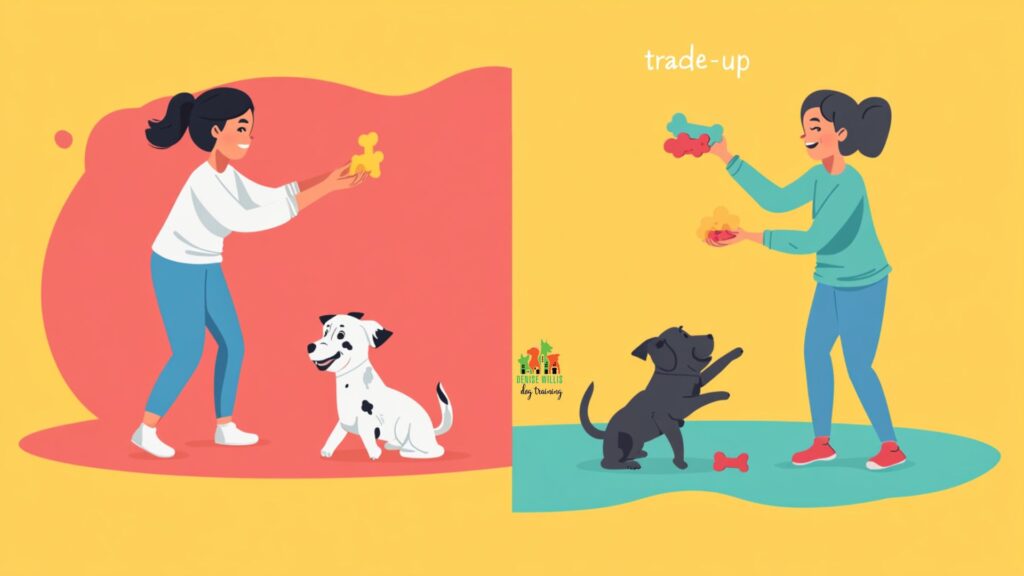
Frequently Asked Questions About Resource Guarding in Puppies
Q: Can puppies grow out of resource guarding?
A: Contrary to popular belief, puppies don’t typically “grow out” of resource guarding. Without intervention, this behavior often intensifies with age. That’s why early prevention and training are crucial. The good news is that with consistent training and positive experiences, puppies can learn that they don’t need to guard their resources.
Q: What breeds are more prone to resource guarding?
A: While any breed can develop resource guarding behaviors, some breeds may be more predisposed due to their history or breeding. In my experience, I’ve seen a higher prevalence in breeds like Cocker Spaniels, Golden Retrievers, and some Poodle crosses. However, individual personality and experiences play a much larger role than breed. It’s important to remember that every dog is an individual, regardless of their breed.
Q: How can I tell if my puppy is playing or guarding a toy?
A: Playful behavior is usually loose and wiggly, with a relaxed body posture. Guarding behavior typically involves stiffening, freezing, or showing signs of stress like whale eye or growling. If you’re unsure, it’s best to err on the side of caution and treat it as potential guarding. Look for signs like:
- Playful behavior: Tail wagging, bouncy movements, play bows, relaxed facial expressions
- Guarding behavior: Stiff body, hard stare, lowered head, growling, snapping
Q: Is it okay to take things away from my puppy to show them I’m the boss?
A: Absolutely not. This approach can actually increase anxiety and worsen guarding behaviors. Instead, focus on teaching your puppy that giving up items voluntarily leads to positive outcomes. The goal is to build trust, not to establish dominance. Remember, resource guarding is about insecurity, not a desire to be “boss.”
Q: Can neutering or spaying help with resource guarding?
A: While neutering or spaying can help with some behavioral issues, it’s not a direct solution for resource guarding. This behavior is more about anxiety and learned responses than hormones. Proper training and behavior modification are the most effective approaches. However, if hormonal aggression is contributing to the problem, neutering or spaying might be part of a comprehensive treatment plan.
Q: My puppy only guards high-value items. Is this normal?
A: It’s common for puppies to guard items they perceive as highly valuable. This could be a favorite toy, a chew, or a particularly tasty treat. However, it’s still important to address this behavior to prevent it from escalating or generalizing to other items. Use the techniques we’ve discussed, starting with lower-value items and gradually working up to the high-value ones.
Q: How long does it typically take to see improvement in resource guarding behavior?
A: The timeline for improvement can vary greatly depending on the individual puppy, the severity of the guarding, and the consistency of training. Some puppies might show improvement in a few weeks, while others might take months. The key is to be patient and consistent. Remember, you’re not just stopping a behavior; you’re teaching your puppy a new way of thinking about resources.
Resource Guarding in Puppies Quiz
Recommended Products for Managing Resource Guarding
Here are some products that can be helpful in preventing and managing resource guarding in puppies:
- Kong Classic Dog Toy: These durable rubber toys are great for redirecting your puppy's attention and providing mental stimulation. You can stuff them with treats or kibble, making them perfect for the "trade-up" game. The unpredictable bounce also makes them great for interactive play, helping to build your bond with your puppy.
- Outward Hound Fun Feeder Slow Feed Dog Bowl: These bowls can help make mealtimes more engaging and less stressful for puppies prone to food guarding. By slowing down eating, they also provide an opportunity for you to approach and add treats to the bowl, reinforcing positive associations with your presence during meals.
- PetSafe Busy Buddy Tug-A-Jug Meal-Dispensing Dog Toy: This toy dispenses treats as your puppy plays, making it a great tool for positive associations with giving up resources. It's also excellent for mental stimulation, which can help reduce anxiety-related behaviors like resource guarding.
- Zak George's Dog Training Revolution: The Complete Guide to Raising the Perfect Pet with Love: This book offers comprehensive advice on puppy training, including sections on resource guarding. It aligns with positive reinforcement methods and provides step-by-step guidance for various training scenarios.
- ThunderEase Dog Calming Pheromone Diffuser Kit: While not a direct solution for resource guarding, this can help reduce overall anxiety in puppies, which may contribute to guarding behaviors. It releases calming pheromones that can help create a more relaxed environment for your puppy.
Remember, while these products can be helpful tools, they should be used in conjunction with consistent training and positive reinforcement techniques. No product is a magic solution, but when used as part of a comprehensive training plan, they can be valuable aids in preventing and managing resource guarding.
Further Reading
As we've explored the intricacies of resource guarding in puppies, you might find yourself hungry for more knowledge about dog behavior and training. After all, understanding your furry friend is a journey, not a destination. The following articles delve deeper into related topics that can complement your efforts in preventing and managing resource guarding:
- 10 Essential Tips for Socializing Your Puppy and What Not to Do: Proper socialization is crucial in preventing resource guarding. This article provides valuable insights into introducing your puppy to new experiences, people, and other dogs in a positive way. By following these tips, you'll help your puppy build confidence and reduce the likelihood of developing guarding behaviors.
- 5 Proven Strategies to Stop Your Dog's Aggression Towards Other Dogs: While not directly about resource guarding, this piece offers strategies that can be adapted to manage guarding behaviors, especially in multi-dog households. The principles of managing dog-to-dog aggression often overlap with those used to address resource guarding.
- Decoding Your Dog: 15 Body Language Signals You Need to Know: Understanding your puppy's body language is essential in identifying early signs of resource guarding. This article will help you become fluent in "dog speak," allowing you to intervene early and effectively when guarding behaviors start to emerge.
- 5 Simple Hacks to Stop Your Dog's Resource Guarding: This piece offers additional techniques to complement the strategies we've discussed, providing you with even more tools to address resource guarding. These hacks can be particularly useful for owners who are dealing with more persistent guarding behaviors.
- Puppy Training Classes in Baltimore: If you're in the Baltimore area, this article will guide you to professional training resources that can provide hands-on help with resource guarding and other puppy behaviors. Group classes can also offer controlled environments for your puppy to practice sharing and interacting with other dogs.
By exploring these articles, you'll gain a more comprehensive understanding of your puppy's behavior and the various factors that influence it. Remember, resource guarding doesn't exist in a vacuum – it's often intertwined with other aspects of your puppy's personality and experiences. The more you learn about dog behavior in general, the better equipped you'll be to create a happy, healthy environment for your furry friend.
Each of these articles builds on the foundation we've laid here, offering deeper insights into specific aspects of puppy behavior and training. Whether you're looking to enhance your understanding of canine body language, explore additional training techniques, or find local resources for hands-on help, these articles will serve as valuable next steps in your journey to raise a well-adjusted, confident puppy.
Final Thoughts
Resource guarding in puppies is a challenging but manageable behavior. With early intervention, consistency, and positive reinforcement, you can help your puppy develop a healthy relationship with their resources and the world around them. Remember, every puppy is unique, and what works for one may not work for another. Be patient, stay positive, and don't hesitate to seek professional help if you're struggling.
Throughout this article, we've covered the essentials of understanding, preventing, and managing resource guarding:
- We've explored why puppies guard resources and how to recognize the early signs.
- We've outlined 10 simple steps you can take to prevent resource guarding from developing or worsening.
- We've looked into specific training techniques like the "Trade-Up" game and desensitization exercises.
- We've addressed common questions about resource guarding and provided product recommendations to support your training efforts.
The key takeaway is this: resource guarding is not about your puppy being "dominant" or "bad." It's a natural behavior rooted in insecurity or anxiety. By addressing these underlying emotions and consistently reinforcing positive behaviors, you can help your puppy feel secure and confident.
At DW Dog Training, we're committed to helping you and your puppy build a strong, trusting relationship. If you're dealing with resource guarding or any other puppy training challenges, we're here to help. Our personalized training programs are designed to address your specific needs and concerns. We understand that every puppy-owner relationship is unique, and we tailor our approach to suit your individual situation.
We'd love to hear about your experiences with resource guarding. How has it affected your relationship with your puppy? What strategies have you tried? What challenges are you still facing? Share your thoughts in the comments below or contact us directly. Your journey could provide valuable insights for other puppy owners facing similar challenges.
Remember, you're not alone in this journey.
Many puppy owners have faced resource guarding and successfully overcome it. With the right guidance and a lot of love, you and your puppy can do the same. Let's work together to give your puppy the best start in life!
Whether you're just starting out with a new puppy or you're dealing with established guarding behaviors, there's always hope for improvement. Don't let resource guarding stand in the way of the joyful, trusting relationship you and your puppy deserve. Reach out today, and let's take the first step towards a happier, more harmonious life with your furry friend.
Your experiences and questions not only help us improve our services but also contribute to the wider community of dog owners. So don't be shy – share your story, ask your questions, and let's continue this important conversation about resource guarding in puppies. Together, we can create a world where puppies feel secure, owners feel confident, and the bond between humans and their canine companions grows ever stronger.

